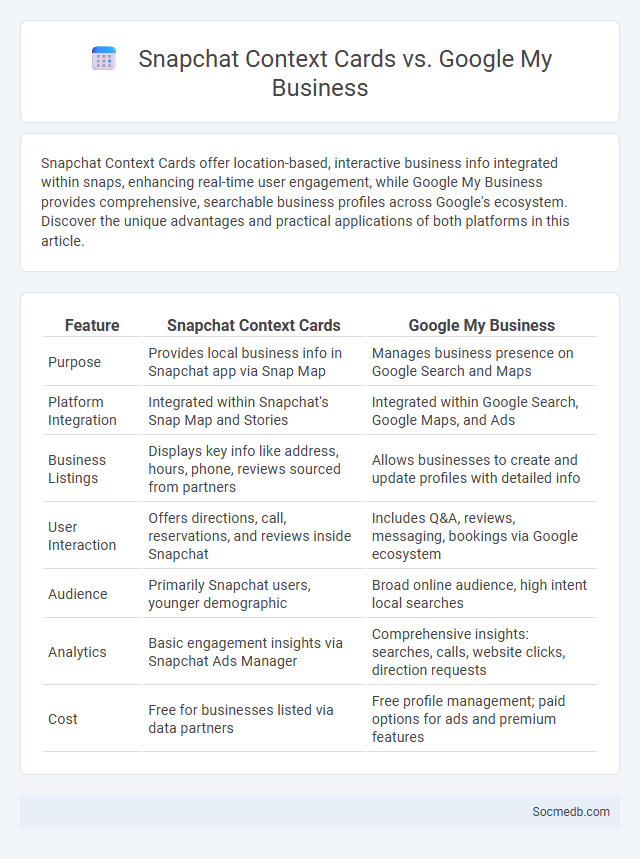
Photo illustration: Snapchat Context Cards vs Google My Business
Snapchat Context Cards offer location-based, interactive business info integrated within snaps, enhancing real-time user engagement, while Google My Business provides comprehensive, searchable business profiles across Google's ecosystem. Discover the unique advantages and practical applications of both platforms in this article.
Table of Comparison
| Feature | Snapchat Context Cards | Google My Business |
|---|---|---|
| Purpose | Provides local business info in Snapchat app via Snap Map | Manages business presence on Google Search and Maps |
| Platform Integration | Integrated within Snapchat's Snap Map and Stories | Integrated within Google Search, Google Maps, and Ads |
| Business Listings | Displays key info like address, hours, phone, reviews sourced from partners | Allows businesses to create and update profiles with detailed info |
| User Interaction | Offers directions, call, reservations, and reviews inside Snapchat | Includes Q&A, reviews, messaging, bookings via Google ecosystem |
| Audience | Primarily Snapchat users, younger demographic | Broad online audience, high intent local searches |
| Analytics | Basic engagement insights via Snapchat Ads Manager | Comprehensive insights: searches, calls, website clicks, direction requests |
| Cost | Free for businesses listed via data partners | Free profile management; paid options for ads and premium features |
Overview: Snapchat Context Cards, Google My Business, and Context Cards
Snapchat Context Cards provide users with detailed information about businesses, locations, and events directly within the app, enhancing local discovery and user engagement. Google My Business enables businesses to manage their online presence across Google Search and Maps, offering essential details such as hours, reviews, and photos to potential customers. Both platforms utilize Context Cards to deliver rich, context-specific data that improves user experience and drives real-world interactions with local businesses.
Key Features Comparison: Snapchat Context Cards vs Google My Business
Snapchat Context Cards offer real-time location-based information, integrating user-generated content, reviews, contact details, and direct actions like booking or calling within the app, enhancing user engagement through visual and interactive elements. Google My Business provides comprehensive business profiles across Google Search and Maps, featuring verified business information, customer reviews, photos, posts, and insights into user interactions, boosting local SEO and online visibility. Unlike Google My Business, which emphasizes search discoverability and broad multi-platform presence, Snapchat Context Cards prioritize immersive, on-the-go user experiences tailored to Snapchat's younger demographic with seamless social sharing and contextual advertising.
User Experience Differences Across Platforms
User experience on social media varies significantly across platforms due to differences in design, interaction style, and content algorithms. Instagram emphasizes visual storytelling with image and video-centric feeds, while Twitter prioritizes real-time updates and concise text-based communication. Understanding these user experience differences helps you choose the platform that best suits your communication style and engagement goals.
Business Visibility and Local Search Impact
Social media platforms significantly enhance business visibility by enabling targeted advertising and customer engagement that drives brand awareness. Integrating location-based features and optimized business profiles on social networks improves local search rankings, attracting nearby customers. Consistent social media activity combined with positive local reviews directly boosts search engine results, increasing foot traffic and online inquiries.
Integrations and Third-Party Partnerships
Social media platforms enhance functionality through integrations and third-party partnerships, enabling seamless content sharing, advanced analytics, and streamlined e-commerce experiences. These collaborations empower you to connect various tools like CRM systems, marketing automation, and customer support, optimizing user engagement and business operations. Leveraging such integrations improves efficiency and delivers personalized interactions aligned with your brand's goals.
Real-Time Information and Updates
Social media platforms provide real-time information and updates that keep you instantly informed about breaking news, trending topics, and live events. This instant access allows quick decision-making and engagement, enhancing your awareness in a constantly evolving digital landscape. By leveraging real-time feeds, you can stay connected to crucial developments as they happen worldwide.
Audience Reach and Demographic Insights
Social media platforms provide extensive audience reach with billions of active users worldwide, allowing your content to connect with diverse demographics across various age groups, locations, and interests. Advanced analytics tools offer demographic insights such as gender distribution, engagement rates, and user behavior patterns, helping to tailor marketing strategies for maximum impact. By leveraging these data-driven insights, you can optimize campaign targeting to increase engagement and improve overall ROI.
Benefits for Local Businesses
Social media platforms enhance local business visibility by enabling targeted advertising to specific geographic areas, increasing customer engagement through interactive content, and facilitating direct communication with the community. Local businesses benefit from cost-effective marketing strategies that boost brand awareness and drive foot traffic. User-generated content and online reviews on social media also build trust and credibility, encouraging repeat business and customer loyalty.
Privacy, Data Sharing, and User Control
Social media platforms collect extensive personal data, raising significant privacy concerns as users often lack full awareness of how their information is shared or utilized. Advanced data sharing practices between social media companies and third-party advertisers increase risks of unauthorized access and misuse of personal information. Empowering users with granular control over their privacy settings and transparent data policies is essential to enhance security and trust in digital environments.
Future Trends in Digital Business Listings
Future trends in digital business listings emphasize increased integration with social media platforms, leveraging AI-driven personalization to deliver hyper-targeted content to users. Enhanced visual elements such as 3D images, videos, and augmented reality experiences are becoming standard to engage audiences more effectively. Voice search optimization and real-time updates will further transform how businesses maintain visibility and interact with potential customers online.
 socmedb.com
socmedb.com